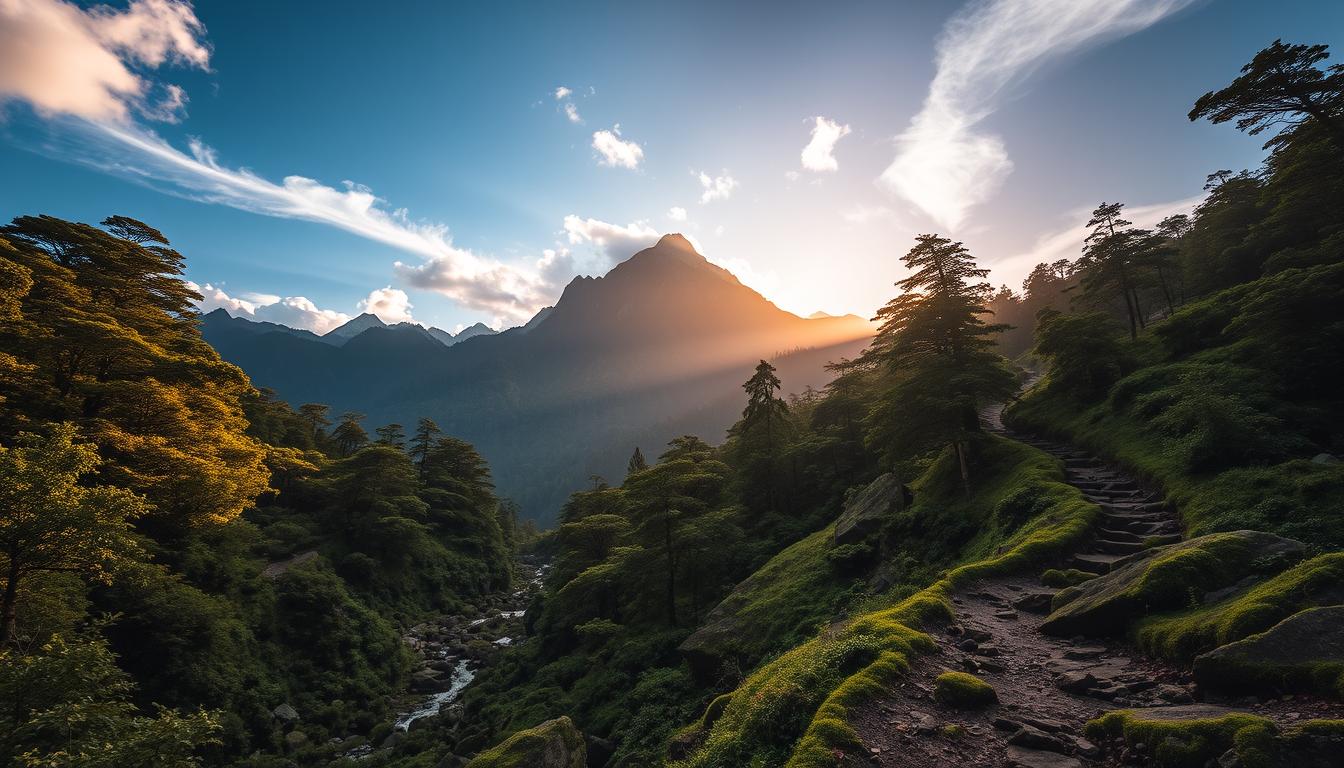Nestled in the majestic Sahyadri Mountains, the Bhimashankar Trek is a revered journey that leads to the sacred Bhimashankar Temple, one of the twelve Jyotirlingas dedicated to Lord Shiva.
This adventure offers a perfect blend of spiritual significance and natural beauty, making it a popular choice among both pilgrims and trekking enthusiasts. The trek features diverse terrain, from dense forests to rocky patches, providing a challenging yet rewarding experience for trekkers of various skill levels.
Key Takeaways
- Discover the ideal time to plan your 2025 adventure
- Understand the trek’s difficulty level and required preparation
- Learn about the diverse terrain and scenic beauty
- Explore the spiritual significance of Bhimashankar Temple
- Get insights into the trek’s location and route options
Overview of Bhimashankar Trek
The Bhimashankar Trek is a unique blend of spirituality and adventure, nestled in the Sahyadri mountains. This trek is not just a journey through the dense forests of the Western Ghats but also a pilgrimage to one of the twelve sacred Jyotirlingas in India.

What Makes Bhimashankar Trek Special
The Bhimashankar Trek stands out due to its unique combination of spiritual significance and natural splendor. Trekkers are treated to an immersive experience in the heart of the Western Ghats, with the trek route passing through dense forests that showcase lush greenery and diverse flora and fauna. The trek is also home to the endangered Indian Giant Squirrel, adding to its biodiversity.
The trek’s appeal is further enhanced by its surrounding wildlife sanctuary, offering opportunities for nature enthusiasts to observe various species in their natural habitat. This makes the Bhimashankar Trek a perfect destination for both adventure seekers and nature lovers.
Bhimashankar Temple and Its Significance
The culmination point of the Bhimashankar Trek is the Bhimashankar Temple, one of the twelve Jyotirlingas in India. Dedicated to Lord Shiva, the temple holds significant religious importance and features ancient architecture that dates back several centuries.
According to legend, the temple marks the spot where Lord Shiva defeated the demon Tripurasura, adding mythological significance to this already spectacular jungle trek destination. The temple’s historical and religious importance makes the trek not just an adventure but also a pilgrimage for many.
Location and Geography of Bhimashankar
Tucked away in the Sahyadri range, Bhimashankar is a trekker’s paradise with its breathtaking landscapes. The trek is situated in the picturesque village of Bhorgiri, surrounded by lush green forests and hills.
Where is Bhimashankar Located
Bhimashankar is located in the ghat region of the Sahyadri Mountains of Maharashtra. The distance from Pune to Bhimashankar is about 110 km, taking around 3 hours and 23 minutes by road. It is approximately 220 kilometers away from Mumbai. The trek’s starting point is typically the base village of Khandas or Bhorgiri.
The village Bhorgiri is strategically positioned, making Bhimashankar accessible yet secluded enough to offer a genuine wilderness experience. Khandas, being approximately 34 km from Karjat railway station, serves as the primary gateway for trekkers coming from major cities.
Surrounding Landscape and Wildlife
The Bhimashankar trek is surrounded by dense forests, cascading waterfalls, and diverse vegetation that changes with the seasons. Situated at an elevation of around 3,250 feet above sea level, it offers breathtaking panoramic views of the surrounding Western Ghats landscape.
The area is part of the Bhimashankar Wildlife Sanctuary, which spans approximately 131 square kilometers and is home to numerous endemic species, including the state animal of Maharashtra – the Indian Giant Squirrel. Near Bhimashankar, you’ll find several other points of interest that can be explored as side trips, including Gupt Bhimashankar, Nagfani Point, and Hanuman Lake.

Difficulty Level of Bhimashankar Trek
With its rugged paths and steep ascents, the Bhimashankar Trek is classified as moderate, appealing to both new and experienced trekkers. The trek is accessible to those with basic fitness levels, though it involves navigating through challenging terrain.
Terrain and Challenges
The terrain varies significantly along the route, with some sections featuring steep ascents, particularly on the Shidi Ghat (Ladder Route), which includes three ladder sections that can be challenging, especially during monsoon season. Trekkers face different challenges depending on the chosen route – Ganesh Ghat offers a longer but gentler ascent, while Shidi Ghat provides a shorter but steeper climb with more technical sections.
- The Shidi Ghat route includes steep ladder sections.
- Ganesh Ghat offers a gentler, longer ascent.
- Weather conditions significantly affect the trek’s difficulty.
Fitness Requirements for Trekkers
Basic fitness requirements include the ability to walk continuously for 4-6 hours, good stamina for uphill climbs, and sufficient leg strength to navigate uneven terrain and occasional rock scrambling. Prior trekking experience is helpful but not mandatory; participants should engage in regular cardio exercises like jogging, swimming, or cycling for at least 2-3 weeks before attempting the trek.
| Fitness Aspect | Description | Preparation |
|---|---|---|
| Continuous Walking | Ability to walk for 4-6 hours | Regular cardio exercises |
| Uphill Climbing | Good stamina for climbs | Strength training |
| Leg Strength | Sufficient strength for uneven terrain | Squats, lunges |
As emphasized by experienced trekkers, “Fitness and adaptation are extremely important. Age doesn’t matter; what counts is being physically fit.” This is echoed by the story of a 4-year-old girl who completed the trek easily, while some younger adults struggled.
“Fitness is key. We’ve seen a 4-year-old complete the trek, and sometimes even 22-25-year-olds can’t finish 10% of it.”
Duration of Bhimashankar Trek
The Bhimashankar trek’s duration varies based on several factors, including the route taken and the trekker’s fitness level. Typically, it takes about 4 to 6 hours to ascend from the base village Khandas to the Bhimashankar Temple, while descending back takes approximately 3 to 4 hours.
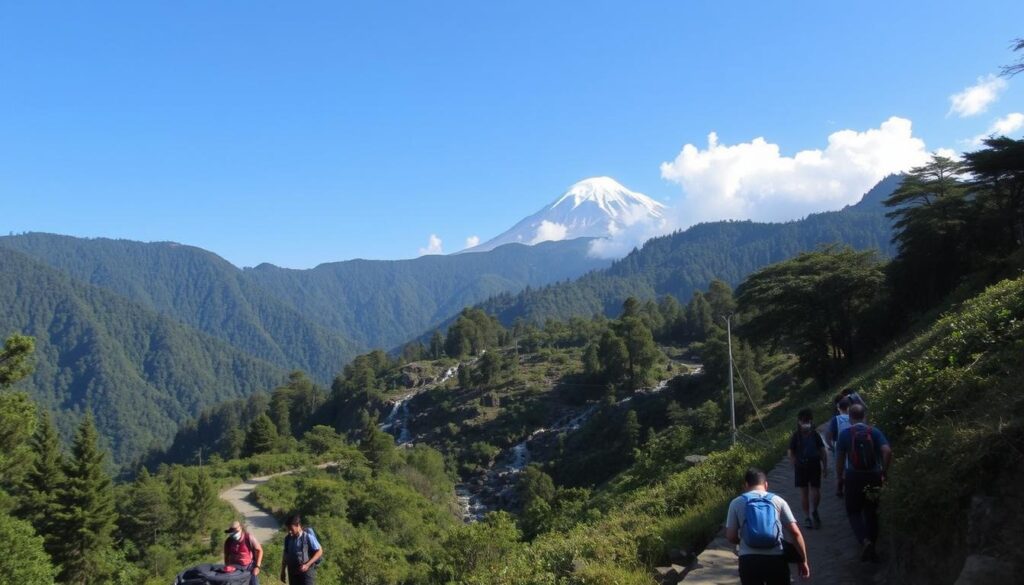
Typical Time Required for Ascent
The ascent time for the Bhimashankar trek can differ significantly based on the chosen route. For instance, the Ganesh Ghat route typically requires 5-6 hours to reach the Bhimashankar Temple from Khandas, as it is longer but has a more gradual incline. On the other hand, the Shidi Ghat or Ladder Route is shorter, taking around 4-5 hours, but demands more technical climbing skills and caution, especially at the ladder sections.
Descent Duration and Considerations
Descent times are generally shorter, with most trekkers completing the return journey in 3-4 hours. However, this can vary based on the route chosen and the speed at which the group moves. Trekkers should also factor in additional time for rest stops, photography, and exploring attractions like Gupt Bhimashankar or Hanuman Lake along the way. As one trekker noted,
“The journey is just as important as the destination, so take your time to enjoy the scenery.”
Overall, the Bhimashankar trek can be completed as a day hike for those maintaining a good speed, but many prefer to make it a two-day journey to fully appreciate the surroundings and avoid rushing.
Best Time to Visit Bhimashankar
Understanding the best time to visit Bhimashankar is crucial for a memorable trekking experience. The region offers diverse experiences across different seasons, making the choice of when to visit important.
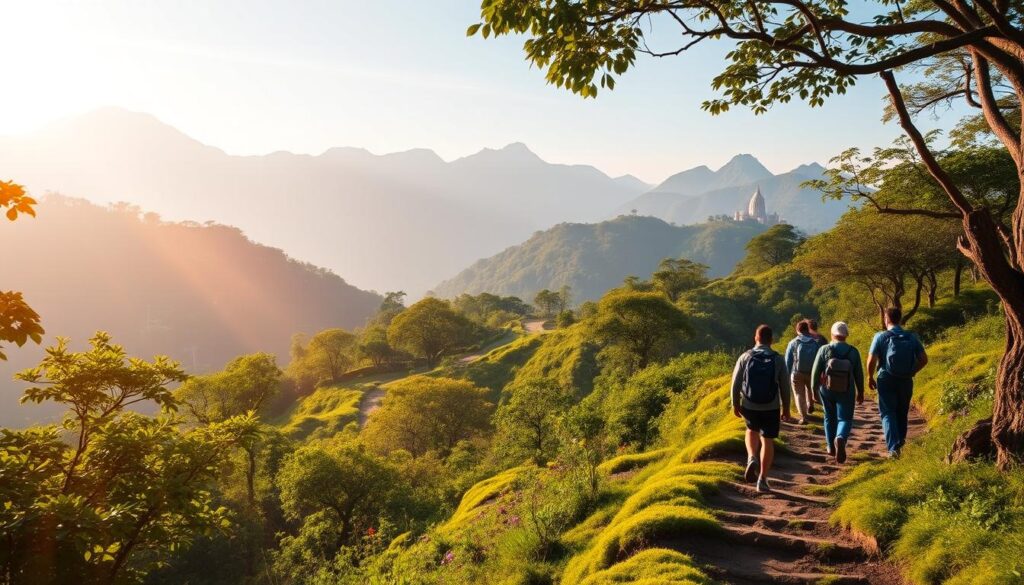
Monsoon Season Experience
The monsoon season, from June to September, transforms Bhimashankar into a lush paradise. The landscape is adorned with lush greenery and numerous seasonal waterfalls, creating a vibrant setting that is particularly appealing to photographers and nature enthusiasts. Trekkers can witness the full glory of the Western Ghats ecosystem, with flowing streams and misty mountain views. However, the trails become more slippery and challenging during this time.
As one treks through the Bhimashankar trek during monsoon, the experience is heightened by the presence of active wildlife and the soothing sounds of flowing water. It’s a time when the region is at its most verdant, offering a unique and refreshing experience.
Winter Season Experience
The winter season, from October to February, offers a different yet equally captivating experience. The clear skies and comfortable temperatures, ranging from 10-25°C, make it an ideal time for trekking. The drier trails and excellent visibility for panoramic views add to the appeal. Trekkers can enjoy the scenic beauty without the challenges posed by monsoon rains.
“Winter is the best time to visit Bhimashankar for those who prefer clearer skies and more comfortable trekking conditions.”
Post-monsoon months, particularly October and November, provide an ideal balance with moderate temperatures and relatively green landscapes. Some waterfalls remain from the monsoon runoff, adding to the scenic beauty.
Trek Routes to Bhimashankar
The journey to Bhimashankar is a thrilling experience, with multiple trek routes offering varying levels of difficulty and scenery. Trekkers can choose from three primary routes, each with its unique characteristics, allowing for a personalized experience based on individual preferences and skill levels.
Ganesh Ghat Route
The Ganesh Ghat Route is the longest but easiest path to Bhimashankar, starting from Khandas village. This route takes approximately 5-6 hours to complete and features a gradual ascent through forested areas. Trekkers will pass by a Ganesh temple about an hour into the journey, and the trail is well-marked with several resting points and food stalls along the way. The route culminates at Hanuman Lake before reaching Bhimashankar Temple, making it an ideal choice for beginners and those who prefer a less strenuous trek.
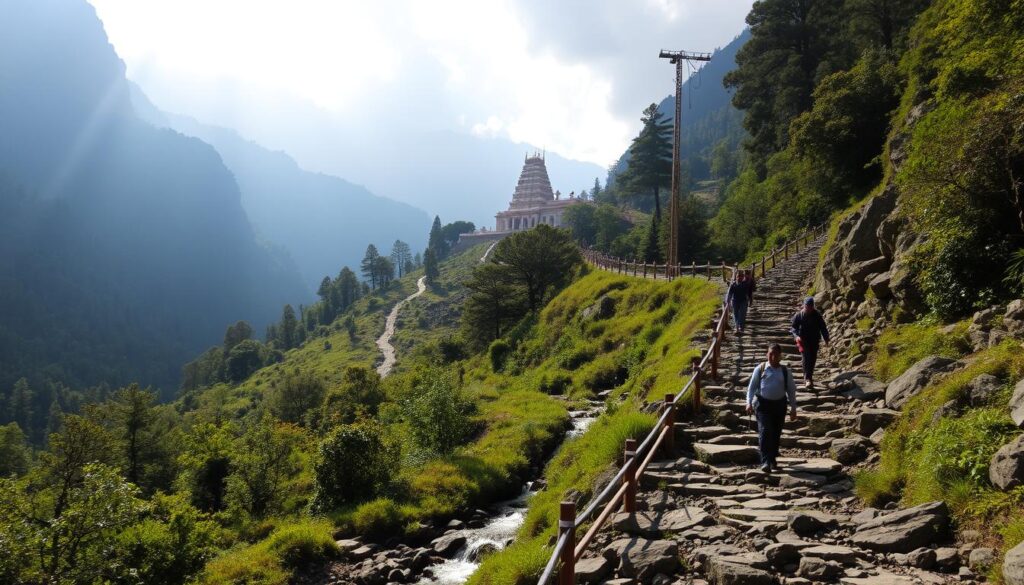
Shidi Ghat (Ladder Route)
The Shidi Ghat, also known as the Ladder Route, offers a more challenging but shorter alternative to Bhimashankar. This route is characterized by three steep ladder sections, requiring good upper body strength and caution, especially during the monsoon season when the metal ladders can be slippery. Despite its challenges, the Shidi Ghat route rewards trekkers with dramatic views and the satisfaction of conquering a more technical path. The route eventually merges with the Ganesh Ghat route at a junction point before reaching Bhimashankar.
- The Ganesh Ghat Route is ideal for beginners and those preferring a less strenuous trek.
- The Shidi Ghat Route is more challenging and requires good upper body strength.
- The Bhorgiri to Bhimashankar Route offers a unique jungle trek experience.
Bhorgiri to Bhimashankar Route
The Bhorgiri to Bhimashankar Route is less frequented but offers a unique jungle trek experience through dense forest. This route takes approximately 3 hours of relatively level walking before reaching Gupt Bhimashankar. It is particularly appealing to wildlife enthusiasts and photographers, as it provides opportunities to spot the Indian Giant Squirrel and various bird species in their natural habitat.
In conclusion, the trek to Bhimashankar offers a range of route options, catering to different trekker preferences and skill levels. Whether you choose the easier Ganesh Ghat Route, the challenging Shidi Ghat Route, or the jungle trek via Bhorgiri, each route provides a unique and rewarding experience.
How to Reach Bhimashankar Base Villages

The first step in the Bhimashankar trek is traveling to the base villages of Khandas or Bhorgiri. Multiple transportation options are available from both Mumbai and Pune, making it relatively easy for trekkers to reach their starting point.
From Mumbai to Khandas
From Mumbai, travelers can take a local train to Karjat railway station, which takes approximately two hours. From Karjat, state transport (ST) buses and private rickshaws are available to reach Khandas village, covering the 34 km distance in about 1-1.5 hours. Alternatively, trekkers can opt for a direct road journey via private vehicle or hired taxi, taking the Mumbai-Pune Expressway and then diverting towards Khandas. The total distance is around 120 km, and the travel time is about 3-4 hours, depending on traffic.
From Pune to Khandas/Bhorgiri
For those starting from Pune, the journey to Bhorgiri base village is more direct, covering approximately 90 km via the Pune-Nashik highway and taking about 2.5-3 hours by road. State transport buses operate from Pune’s Shivajinagar ST Stand to locations near Bhorgiri, though the frequency may be limited. Many trekkers prefer to arrange private transport or join organized trek groups that provide transportation. Both base villages offer basic amenities, including small shops for last-minute supplies, though it’s advisable to stock up on essentials before leaving the major cities.
It’s essential to plan an early start when using public transportation, as the last bus connections to these villages are typically in the early afternoon. This planning will help avoid being stranded and ensure a smooth start to the trek.
Essential Things to Carry for Bhimashankar Trek
To ensure a safe and enjoyable Bhimashankar trek, it’s crucial to pack the right gear. The trek requires careful preparation, including the right clothing, footwear, food, and safety essentials.
Clothing and Footwear
Sturdy trekking shoes with good ankle support and grip are essential for navigating the varied terrain of the Bhimashankar trek. Moisture-wicking clothes, a rain jacket (especially during monsoon), and a warm layer for higher elevations are also crucial. Trekkers should pack clothing that can be layered to adjust to changing temperatures.
Food and Water
Carrying sufficient water is critical – at least 2-3 liters per person. Natural water sources along the route may not be safe for drinking without purification. Food supplies should include high-energy, lightweight options such as trail mix, energy bars, sandwiches, and fruits. These provide sustained energy throughout the trek and can be useful in case of unexpected delays.
Safety and First Aid Essentials
A basic first aid kit is essential for addressing minor injuries or discomfort during the journey. The kit should contain antiseptic cream, band-aids, pain relievers, anti-diarrheal medication, insect repellent, and any personal medications. Additional safety items include a backpack rain cover, a hat or cap for sun protection, sunscreen, a whistle for emergencies, a headlamp or flashlight with extra batteries, a multi-tool or knife, and a fully charged mobile phone.
It’s also important to carry documentation including ID proof, emergency contact information, and a physical map of the trek route in a waterproof pouch. This preparation will help ensure a safe and enjoyable Bhimashankar trek experience.
- Pack sturdy trekking shoes and layered clothing.
- Carry sufficient water and high-energy food supplies.
- Include a basic first aid kit and safety essentials.
Accommodation Options Near Bhimashankar
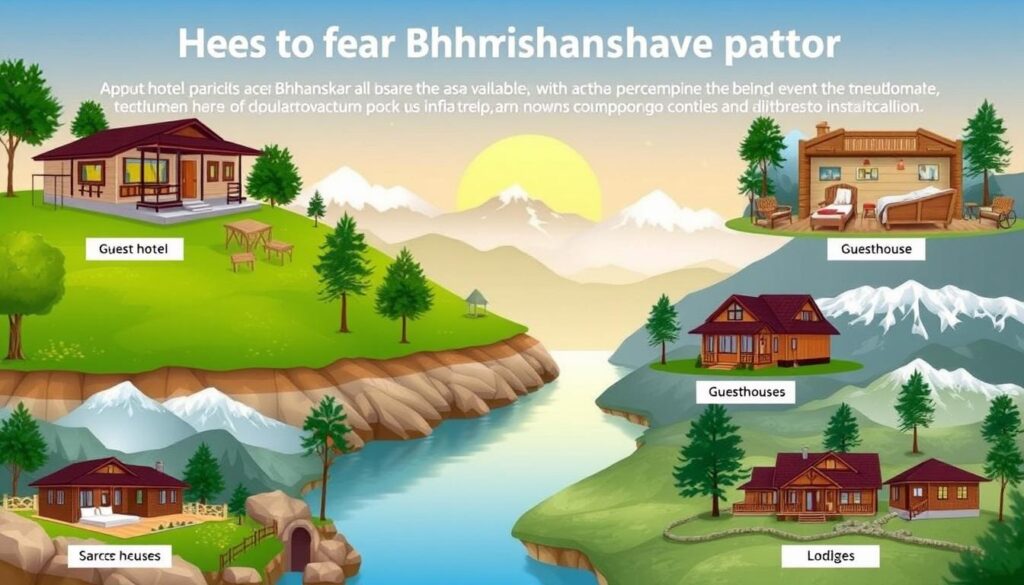
Accommodation near Bhimashankar caters to different preferences and budgets, ensuring a comfortable stay for both trekkers and pilgrims. The options range from basic guesthouses and homestays to more comfortable lodges.
Homestays and Guesthouses
Several homestays in villages near Bhimashankar provide an authentic local experience. These homestays offer simple accommodations, home-cooked meals, and cultural insights. The charges typically range between ₹500-1000 per night, depending on the season and facilities. The Maharashtra Tourism Development Corporation (MTDC) operates a resort near the Bhimashankar Temple, offering clean rooms with basic amenities. Advance booking is recommended, especially during weekends and peak pilgrimage seasons.
For those preferring more comfort, private guesthouses and lodges have emerged in recent years. These offer better amenities but at higher rates. Most require advance booking through their websites or phone reservations. It’s advisable to secure your stay at least 2-3 weeks in advance to avoid disappointment, especially during peak seasons.
Camping Possibilities and Restrictions
Camping directly within the Bhimashankar Wildlife Sanctuary is prohibited to protect the ecosystem. However, there are designated camping areas near the base villages where organized trek groups can set up temporary camps. Some trek organizers include accommodation arrangements as part of their packages, offering tented stays or homestay bookings that save trekkers the hassle of making separate arrangements.
During peak seasons, such as monsoon weekends and winter holidays, accommodation availability becomes limited. Planning ahead is crucial to ensure a smooth and enjoyable trekking experience.
Key Attractions Around Bhimashankar
While the Bhimashankar Temple is a major draw, the surrounding region offers several other key attractions that are sure to captivate trekkers and nature enthusiasts alike. The trekking trail from Bhorgiri to Bhimashankar Temple is not just a path to a revered site; it’s an experience that encompasses breathtaking views and serene landscapes.
Gupt Bhimashankar
Gupt Bhimashankar, located about 2 kilometers from the main temple, is a hidden gem that features a natural rock formation resembling a Shivalinga with water continuously trickling over it. This mystical site is believed to be the original spot where Lord Shiva manifested, creating a serene and spiritual atmosphere that attracts devotees seeking a more secluded experience.
Hanuman Lake
Hanuman Lake, also known as Hanuman Tal, is a picturesque water body situated on the plateau near Bhimashankar Temple. It offers a tranquil spot for rest and reflection during the trek. The lake is particularly beautiful during the monsoon season when it’s filled to capacity, reflecting the surrounding greenery and sky.
Nagfani Point and Other Viewpoints
Nagfani Point, named for its snake hood-like appearance, offers one of the most spectacular viewpoints in the region. The panoramic vistas of the Sahyadri range and valleys below are especially breathtaking during sunrise and sunset. Other notable attractions include the Bhimashankar Wildlife Sanctuary, with opportunities for wildlife spotting, and seasonal waterfalls that cascade down the mountainside during and immediately after the monsoon season.
The area around Bhimashankar is a haven for nature lovers and adventure seekers. With its diverse attractions, including Gupt Bhimashankar, Hanuman Lake, and Nagfani Point, the region offers a rich and varied experience that complements the spiritual significance of the Bhimashankar Temple.
Safety Tips and Precautions
Ensuring safety is crucial for trekkers embarking on the Bhimashankar trek. With proper preparation and awareness of potential hazards, trekkers can significantly reduce risks and enjoy a safe journey.
Weather-Related Precautions
The Sahyadri mountains are known for their unpredictable weather. During the monsoon season, trekkers should be prepared for sudden heavy rainfall, slippery trails, and swollen streams that may require careful crossing. It’s advisable to check weather forecasts before starting the trek and be willing to postpone if severe conditions are predicted. Proper trekking shoes with good grip are essential for safety, especially on steeper sections of the trail. Trekking poles can provide additional stability on slippery or uneven terrain.
Emergency Contacts and Mobile Connectivity
It’s highly recommended to trek in groups rather than alone. Having companions ensures help is available in case of injuries or emergencies. Mobile connectivity is limited throughout much of the trek, with the Jio network generally providing the best coverage, though even this is intermittent. Trekkers should inform someone not on the trek about their itinerary and expected return time. Important emergency contacts to save include the local forest department office, the nearest medical facilities in Khed and Karjat, and the emergency support number of the trek organization, if traveling with one.
A basic first aid kit is essential, and at least one person in the group should have basic first aid knowledge to handle minor injuries until professional help can be reached if needed.
Planning Your Bhimashankar Trek Itinerary
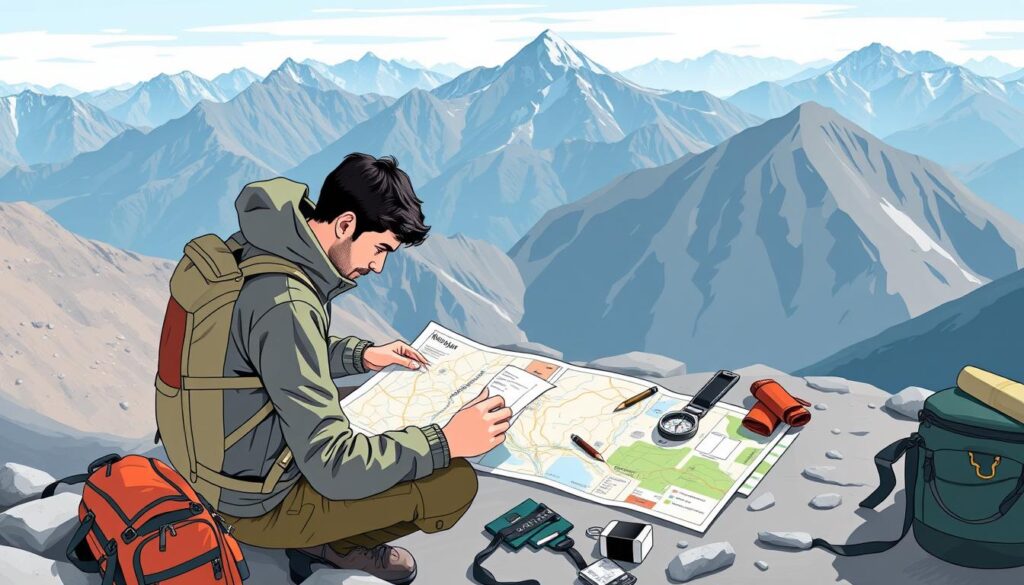
To make the most of your Bhimashankar trek, careful itinerary planning is necessary. The Bhimashankar trek offers two primary itinerary options: a one-day trek plan and a two-day trek plan, each catering to different preferences and fitness levels.
One-Day Trek Plan
For those opting for a one-day trek, an early start is crucial. Trekkers should begin their ascent from the base village by 6:00 AM to ensure sufficient time for the climb, visiting the Bhimashankar Temple, and returning before nightfall. This schedule demands a good level of fitness and minimal breaks, allocating 4-5 hours for ascent, 1-2 hours for temple visit and exploration, and 3-4 hours for descent, making it a challenging 10-12 hour day.
Two-Day Trek Plan
A two-day trek plan provides a more relaxed and comprehensive experience. On the first day, trekkers ascend to Bhimashankar, explore the temple dedicated to Lord Shiva, and stay overnight in local homestays or guesthouses. This extended itinerary allows for witnessing sunset or sunrise from viewpoints, exploring attractions like Gupt Bhimashankar and Hanuman Lake, and interacting with local people, adding a cultural dimension to the journey.
For a two-day trek, advance booking of accommodation is essential, especially on weekends when the number of visitors increases. Most trek organizers handle these arrangements as part of their packages, with group sizes typically ranging from 15-25 participants per batch.
Conclusion
Bhimashankar trek stands out as a unique blend of adventure, spirituality, and breathtaking natural beauty. Throughout this guide, we’ve explored the essential aspects of planning your Bhimashankar trek, from understanding the moderate difficulty level and typical duration to choosing between different trek routes and preparing the right things to carry for a safe journey.
The Bhimashankar Temple, dedicated to Lord Shiva, is a significant highlight, set amidst lush greenery and surrounded by the majestic Sahyadri mountains. Whether you opt for the Ganesh Ghat route or the more challenging Shidi Ghat path, the destination rewards trekkers with a rich experience. Attractions like Gupt Bhimashankar, Hanuman Lake, and panoramic viewpoints add depth to the adventure, making it worth allocating sufficient time to explore the area fully.
When planning your trek date, consider the seasonal variations – monsoon offers spectacular waterfalls and vibrant greenery, while winter provides clearer views and more comfortable trekking weather. Proper preparation is key to safety, including appropriate trekking shoes and clothing, emergency contacts, and first aid supplies. Whether you join an organized batch with inclusions like transportation and breakfast or plan an independent adventure, the memories created during the Bhimashankar trek will likely remain with you long after you’ve returned to the base village.

